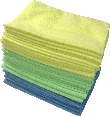Removing Mildew from Furniture
Written by Lee Wyatt (last updated February 18, 2019)
Carpeting and walls are not the only items that are susceptible to mold and mildew in the home. Often one of the most over looked (at least until it is too late) items is the furniture that you have around the home. Whether this furniture is inside or out, if it happens to get wet enough you could find yourself faced with some problems. Luckily, removing mildew from furniture isn't a terribly difficult process. That being said, it is a rather tedious process.
- Dry immediately. When removing mildew from furniture, the very first thing that you need to do is get it dry as quickly as possible. If you have the ability to do, move everything outside into the sun so that it is exposed to open air and the sun as much as possible. Mold and mildew tends to like growing in dark and dank spaces, and the open outside is anything but.
- Dismantle if possible. While the furniture is sitting outside to dry, dismantle as much of it as you can to help ensure quicker drying. This will help to ensure that there are no patches or parts of furniture that is still damp, and allow the air and sun to get to as many parts of the furniture as is possible.
- Clean all the hard stuff. Once the furniture has finally dried, you need to begin using a degreaser and germicide to clean all of the hard portions of the furniture that you can reach. This will help ensure that you have removed all of the "food" material that mold and mildew love to feed off of. If the hard portions of the furniture are actually made of wood, be sure that the cleaners you are using are safe for the wood, and that it won't damage it in any way.
- Clean the upholstery. To get the upholstery cleaned on your furniture your best bet would be to take those portions of the furniture into a professional cleaners, and have them do the job for you. Such professionals are best equipped to deal with the deep and detailed cleaning that will be required. When you take the upholstered portions of your furniture to the cleaners, be sure that you tell them what happened, so that they will use the proper cleaning agents and germicides necessary to get everything clean.
- If all else fails...In the event that everything else fails, and you are unable to completely remove the mold from your furniture, there is one option left. Replace it. Either replace the damaged portions of the furniture, or completely replace all of the furniture. Without a doubt this is the most drastic, and expensive, step available but it will ensure that no mold or mildew will be spread around.
Author Bio
Lee Wyatt
Contributor of numerous Tips.Net articles, Lee Wyatt is quickly becoming a regular "Jack of all trades." He is currently an independent contractor specializing in writing and editing. Contact him today for all of your writing and editing needs! Click here to contact. Learn more about Lee...
Picking a Good Off-Road Vehicle
Deciding on your next off-road vehicle purchase does not have to be as tough of a task as you may once have thought. Here ...
Discover More
Avoiding Cross Contamination
While it may seem like a fairly simple prospect, avoiding cross contamination is really anything but. At least that is ...
Discover More
Basic Care of Rats
Next to hamsters and gerbils, a pet rat is one of the more popular small pets that you can get. If you are thinking of ...
Discover More
Removing Salt Stains
While the snow and ice of winter can be a beautiful sight, the salt that generally comes out at the same time can create ...
Discover More
Mold Cleaning
Mold is a problem for many people. The key is to remove it using the proper tools and eliminate the source of the mold.
Discover More
Mustard Stain Removal
Mustard contains a yellow dye that stains clothing, often permanently. If possible, use bleach or a stain-removing ...
Discover More

Comments